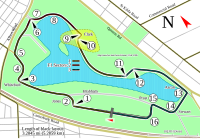2016 Australian Grand Prix
| Race details | |||
|---|---|---|---|
| Race 1 of 21 in the 2016 Formula One season | |||
 |
|||
| Date | 20 March 2016 | ||
| Official name | 2016 Formula 1 Rolex Australian Grand Prix | ||
| Location | Melbourne Grand Prix Circuit, Melbourne, Australia | ||
| Course | Temporary street circuit | ||
| Course length | 5.303 km (3.295 mi) | ||
| Distance | 57 laps, 302.271 km (187.822 mi) | ||
| Scheduled Distance | 58 laps, 307.574 km (191.118 mi) | ||
| Weather | Partly cloudy 22–23 °C (72–73 °F) air temperature 26–36 °C (79–97 °F) track temperature 4 m/s (8.9 mph; 14 km/h) wind from the south |
||
| Pole position | |||
| Driver | Mercedes | ||
| Time | 1:23.837 | ||
| Fastest lap | |||
| Driver |
|
Red Bull-TAG Heuer | |
| Time | 1:28.997 on lap 49 | ||
| Podium | |||
| First | Mercedes | ||
| Second | Mercedes | ||
| Third | Ferrari | ||
|
|
|||
The 2016 Australian Grand Prix (formally known as the 2016 Formula 1 Rolex Australian Grand Prix) was a Formula One motor race that was held on 20 March 2016 in Melbourne. The race was contested over fifty-seven laps of the Melbourne Grand Prix Circuit and was the first round of the 2016 FIA Formula One World Championship. The race marked the eightieth race in the combined history of the Australian Grand Prix—which dates back to the 100 Miles Road Race of 1928—and the twenty-first time the event was held at the Melbourne Grand Prix Circuit. Mercedes driver Lewis Hamilton was the defending race winner.
Hamilton took the first pole position of the season and the fiftieth of his career in a qualifying session that saw the introduction of a new one-by-one elimination format that was widely criticised. His teammate Nico Rosberg took victory ahead of Hamilton and Ferrari's Sebastian Vettel. The race was stopped on lap 18 following an accident involving Fernando Alonso and Esteban Gutiérrez. Mercedes used the break for a change of tyres that allowed their drivers to take a 1–2 finish after Vettel had initially led the race from the start. Romain Grosjean finished sixth, scoring points for the Haas F1 team on their début, the first completely new team to do so since 2002. Mercedes equalled the record for most consecutive 1–2 finishes, by achieving their fifth in a row.
The race saw the introduction of a new qualifying system. As before, qualifying was divided into three parts. However, instead of eliminating the slowest drivers at the end of each respective session, the slowest driver at a given point was now eliminated from contention every ninety seconds, with the countdown starting some minutes into every session.
...
Wikipedia

